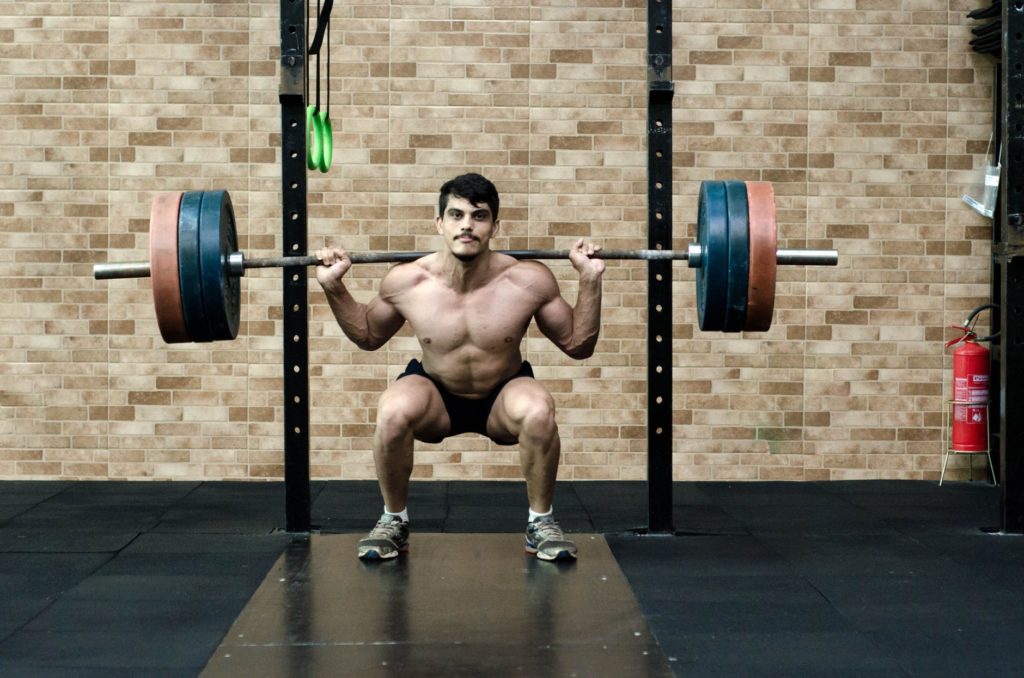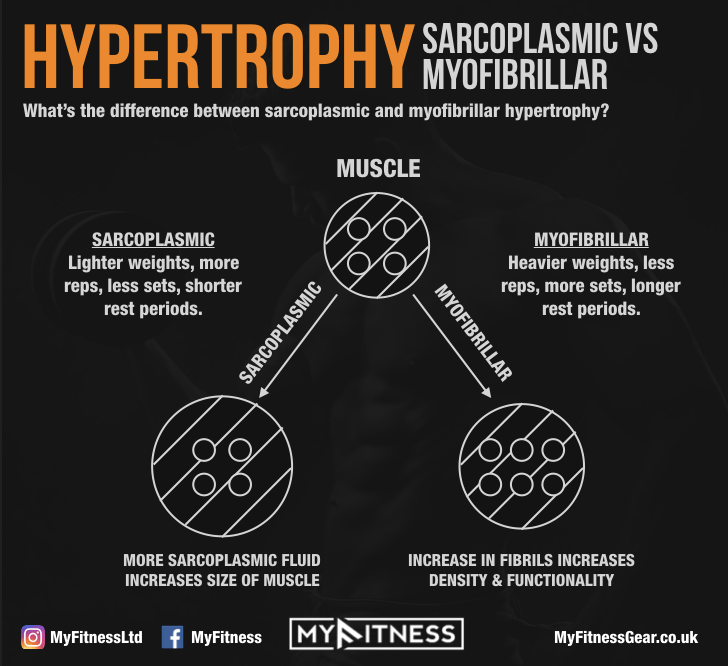What’s the difference between sarcoplasmic hypertrophy and myofibrillar hypertrophy? Well, they’re both muscle growth, as the word “hypertrophy” refers to the growth or enlargement of an organ or tissue, due to the increase in size of its cells. But, at the same time, they couldn’t be more different, and you may want to focus more on one than the other when hitting the gym.
Sarcoplasmic Hypertrophy
Sarcoplasmic hypertrophy refers to an increase in the volume of sarcoplasmic fluid in the muscle cell, with no actual increase in muscular strength. Think “the pump”. This kind of hypertrophy is what bodybuilders tend to focus on when maximising overall size of their muscles.
Sarcoplasm is actually the fluid and energy resources surrounding the myofibrils in your muscles. It contains ATP, glycogen, creatine phosphate and water. So, sarcoplasmic hypertrophy occurs when the volume of sarcoplasmic fluid in your muscle cells increase.

With sarcoplasmic hypertrophy, the muscles are adapting to last longer with less of a need for maximum strength and speed in briefer periods. This would add to muscle volume, but not grow muscle fibres, resulting in less functional mass and a reduction in relative strength, as it would be adding less useful bodyweight overall.
Essentially: sarcoplasmic hypertrophy is a kind of artificial muscle growth. You’re training the muscle for no other reason than to increase it’s size visually by increasing the amount of fluid it can hold, but you’re not increasing the density of the muscles fibres.

- Quantity: 1kg (1000g)
- Type: Pure Creatine Monohydrate
- Features:
- Optimal solubility
- Vegan-friendly
- Free from additives
- Offered in its pure powdered form
Note: Always consult a healthcare professional before starting any supplement regimen.
How to Train for Sarcoplasmic Hypertrophy
If you wish to train for sarcoplasmic hypertrophy alone, you should be doing workouts that are high volume, with rest periods at 60 seconds and below. Reps should be in the 8-15 range and sets should be around the 3-4 count.
When you train for sarcoplasmic hypertrophy, you’ll most likely find that muscles can recover quickly and workouts aren’t too strenuous on your central nervous system. Therefore, you should aim to train each muscle group at least twice per week. Consider an upper/lower split or a push/pull/legs split.
Myofibrillar Hypertrophy
With myofibrillar hypertrophy, think strength and powerlifters. A powerlifter is a functional athlete that trains specially to become more powerful, focusing solely on lifting more weight in an extremely short rep range. A powerlifter will often be much smaller than a bodybuilder, but easily out-perform them when it comes to actually using the muscles to shift heavy weights.

When training for myofibrillar hypertrophy, actin and myosin contractile proteins actually increase in number and add to the actual strength of a muscle, as well as a small increase in the size of the muscle, due to the body treating the small ‘tears’ in the muscle fibres as injuries, sealing and strengthening them with more proteins.
In layman’s terms, you’re slightly damaging the muscles by putting them under extreme stress, causing them to adapt to larger loads. They then become more functionally strong and slightly larger in size, due to an increase in cells recruited.
How to Train for Myofibrillar Hypertrophy
When training for myofibrillar hypertrophy, you’ll be focusing mainly on strength. This means your rep ranges will be around 1-5 and your rest times around 3-5 minutes. However, you’ll be doing more sets – say, 5-10. You’ll be spending most of your time completing large compound lifts such as overhead presses, bench presses, deadlifts, squats and rows.
Training for both performance and size
Unless you want to focus solely on one side of hypertrophy, it makes sense to take a hybrid approach to your training if you wish to be both functional and aesthetic. Consider adding one big lift to each of your workouts and completing it in the heavy myofibrillar rep and set ranges.


- Dosage: 1200mg
- Purity: 98% Maximum Purity Ecdysterone
- Benefits:
- Supports lean muscle building
- Enhances strength gains
- Promotes endurance and muscle growth
- Quantity: 60 capsules
- Supply Duration: 1 month
Note: Always consult a healthcare professional before starting any supplement regimen.
By increasing your strength and functionality in the big lifts, you will increase your lifting ability when doing sarcoplasmic workouts, resulting in better overall results.
Is sarcoplasmic or myofibril hypertrophy better?
“Sarcoplasmic hypertrophy” and “myofibrillar hypertrophy” refer to two types of muscular growth, both of which have their own characteristics and applications. Whether one is “better” than the other depends on the specific goals of an individual.
- Sarcoplasmic Hypertrophy:
- Definition: This refers to an increase in the volume of the semi-fluid, gel-like substance (sarcoplasm) within the muscle cell. This substance supports various functions within the muscle, like glycolysis.
- Characteristics: Sarcoplasmic hypertrophy tends to produce muscles with a fuller or “pumped” appearance. The actual contractile proteins (actin and myosin) don’t see as significant an increase in number as with myofibrillar hypertrophy.
- Training typically associated: Bodybuilding-style training with moderate to high repetitions (e.g., 8-15 reps per set) and shorter rest intervals.
- Application: If the primary goal is muscle aesthetics or size, then sarcoplasmic hypertrophy might be of more interest.
- Myofibrillar Hypertrophy:
- Definition: This is growth that involves an increase in the size and number of the actin and myosin filaments within the muscle fibers, thereby increasing the muscle’s ability to generate force.
- Characteristics: It doesn’t produce as much of a “pumped” appearance as sarcoplasmic hypertrophy, but it contributes more to muscle strength.
- Training typically associated: Strength training routines that use lower repetitions (e.g., 1-6 reps per set) with heavier weights and longer rest intervals.
- Application: If the primary goal is to increase strength, then myofibrillar hypertrophy might be of more interest.
In the real world, these types of hypertrophy don’t occur in isolation. When you train, you’ll experience a combination of both, but the ratios might differ based on your training style. Some arguments in the fitness industry regarding the distinction between these types of hypertrophy suggest that the differences may not be as clear-cut as previously believed.
Which is better?
It depends on your goals:
- If you are focused on muscle size and aesthetics, sarcoplasmic hypertrophy might be emphasized more.
- If you are focused on strength and power, myofibrillar hypertrophy could be the primary goal.
However, it’s crucial to note that maximizing muscle growth and potential probably requires a combination of training styles. This holistic approach can lead to the development of both sarcoplasmic and myofibrillar hypertrophy. Always consult with a fitness professional or personal trainer to determine the best strategy for your individual goals.






